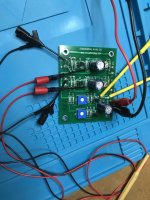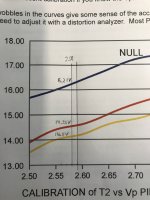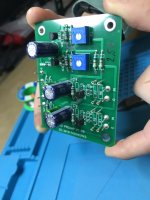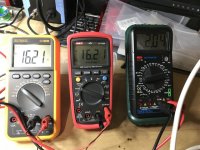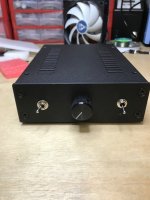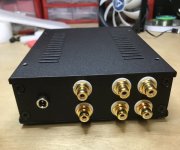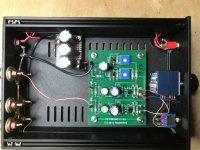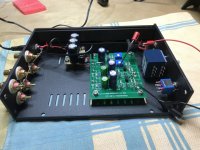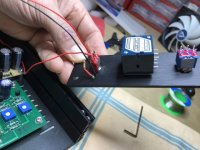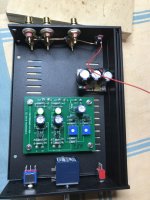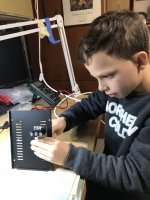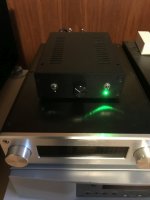At BAF 2019, I did pick up one of the H2 kits that Nelson generously gave away to the attendees. In a discussion there with 6L6 and Gianluca, the idea was born to build with my sons a complete hi-fi for their basement game / “chill” room.
The H2 kit should evolve into a preamp, an ACA should serve as the amp. We already have a speaker kit based on a Fostex 126 that we need to assemble, and the computer-minded of my sons would build the source based on a Raspberry Pi / Hifiberry.
What follows is a pictorial documentation of the H2 preamp build. I bought a small Galaxy case from Modushop, a 10k ALPS pot, two switches, and a few RCA sockets.
I guided my son mostly in layout and the steps of mechanical construction he hadn’t done before, but the actual construction has almost exclusively been his work. In the final assembly, basically the one thing I did was dressing and soldering the very fine signal wires between sockets, switches, and pot.
Here's the first step - marking, drilling and pre-assembling the chassis.
The H2 kit should evolve into a preamp, an ACA should serve as the amp. We already have a speaker kit based on a Fostex 126 that we need to assemble, and the computer-minded of my sons would build the source based on a Raspberry Pi / Hifiberry.
What follows is a pictorial documentation of the H2 preamp build. I bought a small Galaxy case from Modushop, a 10k ALPS pot, two switches, and a few RCA sockets.
I guided my son mostly in layout and the steps of mechanical construction he hadn’t done before, but the actual construction has almost exclusively been his work. In the final assembly, basically the one thing I did was dressing and soldering the very fine signal wires between sockets, switches, and pot.
Here's the first step - marking, drilling and pre-assembling the chassis.
Attachments
-
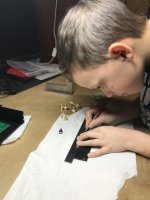 IMG_1291a.jpg315.5 KB · Views: 784
IMG_1291a.jpg315.5 KB · Views: 784 -
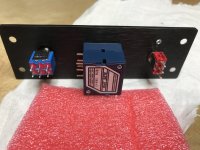 IMG_1306a.jpg375 KB · Views: 350
IMG_1306a.jpg375 KB · Views: 350 -
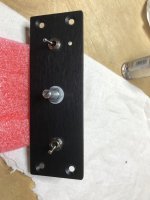 IMG_1303a.jpg365.2 KB · Views: 283
IMG_1303a.jpg365.2 KB · Views: 283 -
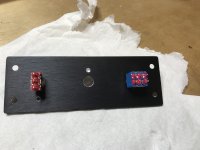 IMG_1302a.jpg295.5 KB · Views: 310
IMG_1302a.jpg295.5 KB · Views: 310 -
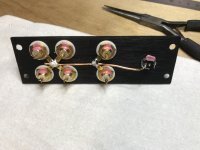 IMG_1301a.jpg304.2 KB · Views: 362
IMG_1301a.jpg304.2 KB · Views: 362 -
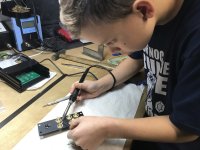 IMG_1297a.jpg332.3 KB · Views: 742
IMG_1297a.jpg332.3 KB · Views: 742 -
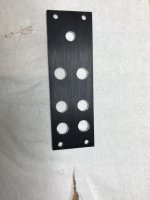 IMG_1296a.jpg325.5 KB · Views: 762
IMG_1296a.jpg325.5 KB · Views: 762 -
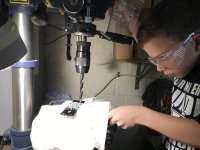 IMG_1295a.jpg293.9 KB · Views: 774
IMG_1295a.jpg293.9 KB · Views: 774 -
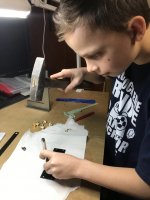 IMG_1294a.jpg338 KB · Views: 778
IMG_1294a.jpg338 KB · Views: 778
At BAF 2019, I did pick up one of the H2 kits that Nelson generously gave away to the attendees. In a discussion there with 6L6 and Gianluca, the idea was born to build with my sons a complete hi-fi for their basement game / “chill” room.
The H2 kit should evolve into a preamp, an ACA should serve as the amp. We already have a speaker kit based on a Fostex 126 that we need to assemble, and the computer-minded of my sons would build the source based on a Raspberry Pi / Hifiberry.
What follows is a pictorial documentation of the H2 preamp build. I bought a small Galaxy case from Modushop, a 10k ALPS pot, two switches, and a few RCA sockets.
I guided my son mostly in layout and the steps of mechanical construction he hadn’t done before, but the actual construction has almost exclusively been his work. In the final assembly, basically the one thing I did was dressing and soldering the very fine signal wires between sockets, switches, and pot.
Here's the first step - marking, drilling and pre-assembling the chassis.
Nice! Great to see the involvement with your son in a project! Looking forward to seeing the rest of the build.
H2 as a preamp – build documentation – part 2 – the H2 board
Besides soldering the H2 board, in this step we also set the voltages according to the calibration curves Nelson provided in his H2 article. Our set of JFETs was marked with Vp = 2.58V, so we set the rail voltages to 16.21V for minimum distortion to start with.
R11, R3, and R8 were raised up from the board, because a quick power dissipation calculation indicated they would get warm. (In use, R3 and R8 indeed get warm, as well as the JFETs to a lesser extent, but R11 not really)
Also, following a hint from Nelson in the H2 thread, we provided sockets for R1/R2 and R6/R7 to modify the gain of the H2 (operated now with inversed resistors, 33k for R1 and 3k3 for R2, to lower the gain).
Besides soldering the H2 board, in this step we also set the voltages according to the calibration curves Nelson provided in his H2 article. Our set of JFETs was marked with Vp = 2.58V, so we set the rail voltages to 16.21V for minimum distortion to start with.
R11, R3, and R8 were raised up from the board, because a quick power dissipation calculation indicated they would get warm. (In use, R3 and R8 indeed get warm, as well as the JFETs to a lesser extent, but R11 not really)
Also, following a hint from Nelson in the H2 thread, we provided sockets for R1/R2 and R6/R7 to modify the gain of the H2 (operated now with inversed resistors, 33k for R1 and 3k3 for R2, to lower the gain).
Attachments
H2 as a preamp – build documentation – part 3 – assembly
Here is the actual assembly of the boards into the chassis and wiring it all up.
As stated, the only task done by me was dressing and soldering the very fine signal wires (Kynar wire; a tip from Zen Mod) to the sockets and switches / pot, because those are somewhat sensitive to heat from the soldering iron ...
Here is the actual assembly of the boards into the chassis and wiring it all up.
As stated, the only task done by me was dressing and soldering the very fine signal wires (Kynar wire; a tip from Zen Mod) to the sockets and switches / pot, because those are somewhat sensitive to heat from the soldering iron ...
Attachments
H2 as a preamp – build documentation – part 4 – first listening impressions
We have tried the H2 preamp in the "main system" for now, because the remainder of the hi-fi systems for the boys isn't built yet.
The H2 sounds absolutely fantastic, in our case we love it in the clean, lowest distortion setting ...
Great bass, too - my son comments that the bass is not only great, but sounds very realistic also ;-)
It seems to have a special synergy with my EL84PP amp, where it seems to provide more "swing" and "feeling" than my Wayne BAF 2018 preamp. Better bass than the BAF preamp, as well. Maybe a bit less transparency, but in this combination barely noticeable. I have set the H2 to lower gain by swapping R1 and R2 resp. R6 with R7 to better match with the high-gain tube amp. I have tried the H2 at the 1% distortion setting as well, but gone back to the "clean" setting, as with the enhanced THD setting the sound somehow lost its "magic". (tried with both polarities of speaker cables at the amp output) I find this interesting, probably needs more examination. The EL84PP at the power levels used is at 0.1% or less H2, and even less H3 ... 😛
(Here's a link to this amp: https://www.diyaudio.com/forums/tubes-valves/185823-unexpectedly-el84-amp-16.html#post5950348)
Yesterday and today, I also tried the H2 with my SissySIT. Here, the pairing of SissySIT with Wayne's BAF 2018 preamp already has plenty of "magic", and is also the most transparent amplification chain I have tried in my system. That's a rare combination to have ... A very fine pairing !🙂
Replacing the BAF 2018 with the H2 didn't bring better synergy. No enhanced magic, and the H2 takes away a noticeable part of the transparency that the BAF 2018 brings ... and that loss is too prominent to make this a winning combo.
So, back to H2 / EL84PP at the moment ... here the H2 proves a better match than the BAF 2018 also because the latter simply has too much gain for the high-gain tube amp, resulting in a bit of noise (tube rush) that can be heard close to the speaker drivers ...
The H2 (clean) with the tube amp is a very fine and engaging combo (had to switch off the music while typing these posts, otherwise I hadn't been able to concentrate ... 😉 )
By the way, I am using the TRIAD switch mode supply that was part of the ACP+ kit from BAF 2019. Works great and is absolutely silent through the speakers. I had tried another SMPS before (seems well made, not one of the very cheap ones), but with that you could hear a bit of "electronic whine" with your ear close to the speaker drivers (the ACP+ was not susceptible to this, interestingly).
We have tried the H2 preamp in the "main system" for now, because the remainder of the hi-fi systems for the boys isn't built yet.
The H2 sounds absolutely fantastic, in our case we love it in the clean, lowest distortion setting ...
Great bass, too - my son comments that the bass is not only great, but sounds very realistic also ;-)
It seems to have a special synergy with my EL84PP amp, where it seems to provide more "swing" and "feeling" than my Wayne BAF 2018 preamp. Better bass than the BAF preamp, as well. Maybe a bit less transparency, but in this combination barely noticeable. I have set the H2 to lower gain by swapping R1 and R2 resp. R6 with R7 to better match with the high-gain tube amp. I have tried the H2 at the 1% distortion setting as well, but gone back to the "clean" setting, as with the enhanced THD setting the sound somehow lost its "magic". (tried with both polarities of speaker cables at the amp output) I find this interesting, probably needs more examination. The EL84PP at the power levels used is at 0.1% or less H2, and even less H3 ... 😛
(Here's a link to this amp: https://www.diyaudio.com/forums/tubes-valves/185823-unexpectedly-el84-amp-16.html#post5950348)
Yesterday and today, I also tried the H2 with my SissySIT. Here, the pairing of SissySIT with Wayne's BAF 2018 preamp already has plenty of "magic", and is also the most transparent amplification chain I have tried in my system. That's a rare combination to have ... A very fine pairing !🙂
Replacing the BAF 2018 with the H2 didn't bring better synergy. No enhanced magic, and the H2 takes away a noticeable part of the transparency that the BAF 2018 brings ... and that loss is too prominent to make this a winning combo.
So, back to H2 / EL84PP at the moment ... here the H2 proves a better match than the BAF 2018 also because the latter simply has too much gain for the high-gain tube amp, resulting in a bit of noise (tube rush) that can be heard close to the speaker drivers ...
The H2 (clean) with the tube amp is a very fine and engaging combo (had to switch off the music while typing these posts, otherwise I hadn't been able to concentrate ... 😉 )
By the way, I am using the TRIAD switch mode supply that was part of the ACP+ kit from BAF 2019. Works great and is absolutely silent through the speakers. I had tried another SMPS before (seems well made, not one of the very cheap ones), but with that you could hear a bit of "electronic whine" with your ear close to the speaker drivers (the ACP+ was not susceptible to this, interestingly).
Attachments
Last edited:
This is great, and a big ‘well done’ to your son! Also appreciate your comments about the ‘clean’ H2 performance. My pots runout before I can get much below 1%, and I’ve been meaning to swap resistors and try it at lower distortion levels. Sounds like it’s worth a try.
Absolutely fantastic! Thanks so much for posting your impressions. More importantly, thanks for showing that you're bringing along another generation of DIYers.


..the idea was born to build with my sons a complete hi-fi for their basement game / “chill” room..
Transmission of the knowledge to Son and how make things is an excellent Father idea and lots of FUN. Super nice!
Congratulations
 Kind regards
Kind regardsThanks for all your nice comments !
Yeah, I learned all the mechanical work from my father as well ... 🙂
Yeah, I learned all the mechanical work from my father as well ... 🙂
Pass DIY Addict
Joined 2000
Paid Member
Awesome work! I worked with my daughters about the time they each turned 9 or 10 to build some ACA amps and speakers to go with them. Great to see others doing the same thing!
@chede
This is awesome.
Could you enlighten the noobs about the specifics of the power pre-filtering you appear to have going on there? I read someplace that Nelson said there could be a benefit to such an arrangement.... Did you happen to take an image of the bottom of your Vero board? What values? Did you listen to it without? Thanks!
This is awesome.
Could you enlighten the noobs about the specifics of the power pre-filtering you appear to have going on there? I read someplace that Nelson said there could be a benefit to such an arrangement.... Did you happen to take an image of the bottom of your Vero board? What values? Did you listen to it without? Thanks!
Hi pfarrell,
I had a look, but actually don't have a picture of the backside of the pre-filter.
It actually is nothing ingenious - I copied the pre-filter from Nelson's ACP+ (see page 7 of his article regarding the ACP+).
So it's an RCRCRC filter. The first R is there to make it easier on the SMPS to start-up when the capacitors are still empty. I believe I used 1500 uF capacitors I had lying around, and adjusted the resistors to 2R2 from 1R because of the lower current draw of the H2 as compared to the ACP+.
I hope this helps - we still like the H2 very much as a preamp (using it in its minimum distortion setting). 😀
All the best, Claas
I had a look, but actually don't have a picture of the backside of the pre-filter.
It actually is nothing ingenious - I copied the pre-filter from Nelson's ACP+ (see page 7 of his article regarding the ACP+).
So it's an RCRCRC filter. The first R is there to make it easier on the SMPS to start-up when the capacitors are still empty. I believe I used 1500 uF capacitors I had lying around, and adjusted the resistors to 2R2 from 1R because of the lower current draw of the H2 as compared to the ACP+.
I hope this helps - we still like the H2 very much as a preamp (using it in its minimum distortion setting). 😀
All the best, Claas
VERY helpful! I'll re-read the ACP article—I'm on the list for that one whenever it hits the store. Thanks! I've built Wayne's 2018 pre and am working on ZM's Iron Pre as well—and 6L6 sent me an H2 kit a while ago... So I'm in preamp interview land—noob style.
- Home
- Amplifiers
- Pass Labs
- H2 as a preamp – build documentation – part 1 – chassis preparation
